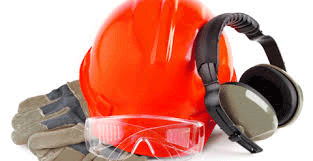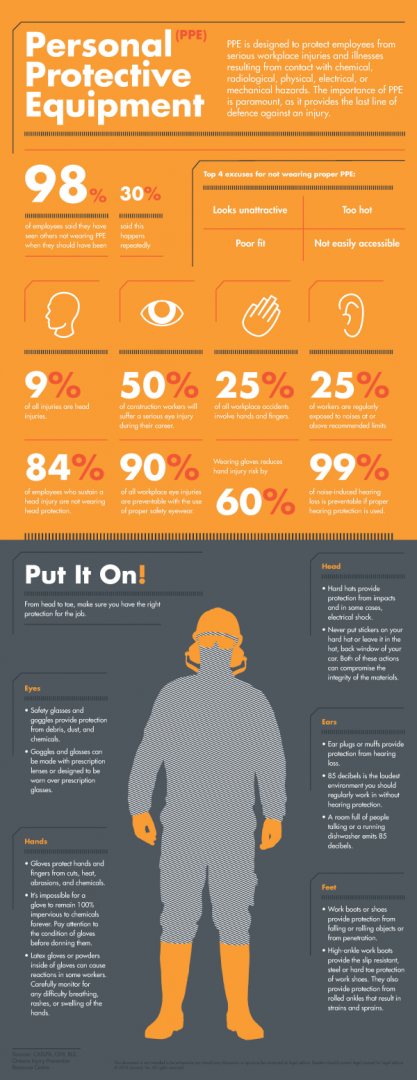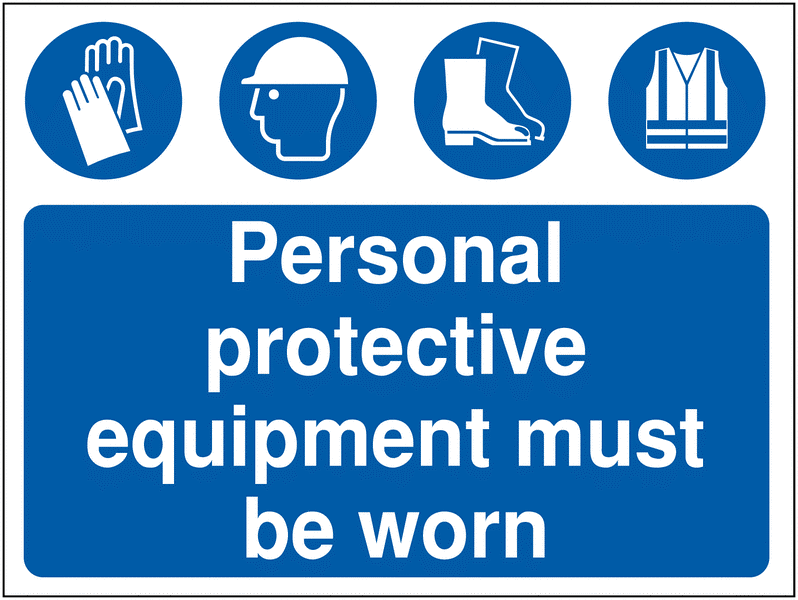The new PPE Regulation (EU) 2016/425 brings about the most significant changes to the rules surrounding PPE, since the introduction of the first Directive over 20 years ago.
The changes are designed to improve ownership of those in the supply chain by clearly defining their legal obligation. As well as to strengthen the product type approval process, improve market surveillance and increase the requirements on certain PPE categories such as hearing protection, due to the potential for life changing injuries.
So this week I thought that I would give you a guide to PPE
This week’s 2 recent HSE cases look at:
- A contractor, client and director have been convicted after conditions at a building site were found to be dangerous
- Dullam & Co (Farmers) Ltd have been fined today after a worker was dragged into a reed combing machine
As ever, if you have a subject that you would like us to cover one week, please contact us by phone 01458 253682, email [email protected] or via our Facebook page or by Twitter.
PPE: Complete guide to Personal Protective Equipment
PPE can include items such as safety helmets, gloves, eye protection, high-visibility clothing, safety footwear, safety harnesses and respiratory protective equipment (RPE). In appropriate situations disposable PPE may be provided; eg single-use coveralls.
Employers have duties concerning the provision and use of personal protective equipment at work
Legal Requirements for PPE
The Health and Safety at Work, etc Act 1974 (HSWA) places a general duty of care on employers for ensuring the safety of their employees and others and requires that no charge may be made for anything done for the purposes of compliance (eg providing PPE). Also, the Management of Health and Safety at Work Regulations 1999 require employers and self-employed people to carry out a suitable and sufficient risk assessment for all work activities for the purpose of deciding what measures are necessary for safety.
The provision of PPE is a legitimate response to the presence of hazards in the workplace, but should only be applied where other measures to remove, reduce or isolate the hazard are likely to prove insufficient.
Regulation 4 of the Personal Protective Equipment at Work Regulations 1992 (the Regulations) makes it clear that employers must provide suitable PPE for employees exposed to health and safety risks except ‘where and to the extent that such risk has been adequately controlled by other means which are equally or more effective’. A similar duty applies to the self-employed with regard to supplying PPE for their own use.
The Regulations also require that:
- where more than one item of PPE is to be worn, that the items are compatible
- PPE is properly assessed before use to ensure it is suitable – to assess the risks which the PPE is to control, to evaluate the characteristics required of the PPE in order for it to be effective against the risks, and to check that the PPE selected has those characteristics
- PPE is maintained in an efficient state, in efficient working order and in good repair (including replacement and cleaning as appropriate)
- appropriate accommodation is provided to store the PPE when it is not being used
- employers take reasonable steps to ensure the PPE is used correctly by employees.
Employees themselves also have duties to use the PPE in accordance with their training, report loss or defect and to store the PPE as instructed. The self-employed similarly have a duty to make full and proper use of PPE.
From April this year, everyone involved in the manufacture, supply and distribution of PPE, is now referred to as ‘Economic Operators’ and are legally responsible to ensure products comply with standards. This will also include online retailers, retailers and generalist distributors who will need to assess the products compliance before making it available. Under the Regulation this is a clearly defined obligation and cannot be passed back into the supply chain.
Duties – Employers
Employers should provide PPE to their employees only where there is a health and safety risk that cannot be adequately controlled by other means.
Where risks cannot be controlled by other means then PPE must be provided. It must:
- be appropriate for the risks and for the working Environment
- take account of the user’s health, ergonomics, fit factors and be compatible with other items of PPE required to be worn
- adequately control the risk presented by the hazard without increasing overall risk experienced by the worker. For example, goggles which are to be used in a hot environment and therefore steam up making it difficult to see
- be supplied free of charge if supplied for work-related health-and-safety reasons
- be properly maintained and suitably stored (in practice, for mobile workers, it may be necessary to supply a holdall or other container to prevent damage to PPE in transit)
- comply with relevant legislation implementing the European Directives concerning the design and manufacture.
Furthermore, there are also considerable differences in physical dimensions of different workers, depending on their gender, ethnicity, and lifestyle, therefore, different sizes and contours should be available to fit wearers. PPE should also be adjustable and where problems occur, advice should be sought to take account of any medical conditions.
In the case of close fitting respiratory protection specific employee fit testing is required. The Wilkins Safety Group can provide this “Face Fit Testing”
Training, instruction and information will also need to be provided to wearers of PPE. In providing this the following details should be included of:
- the risks the PPE will avoid or limit
- the purpose and manner in which the PPE is to be used
- action to be taken by the employee to ensure good working order, as well as hygienic condition.
Any training provided should be comprehensible to those receiving it (literacy and language barriers should be taken into account), and should cover the theory and practice of using PPE with a view to ensuring that users understand not only how to use the PPE, but also why it is important that they do so. Employers should also organise demonstrations of the use of PPE, with regular refresher training. Clearly, the extent of this instruction will depend on the item.
In the case of a high visibility vest simple reinforcement of the requirement to wear it in certain work areas should be sufficient, in the case of a complex item such as a lifejacket or harness, much more detailed instruction is required. Each type of PPE is required to be manufactured to relevant harmonised European standards (CEN standards).
Where PPE is supplied for the first time, it must conform to the appropriate European or British Standard. It is unlawful for suppliers to provide PPE which does not carry the ‘CE’ mark. PPE must be maintained in efficient working order and in good repair in accordance with manufacturers’ maintenance schedules and instructions. An effective system of monitoring and maintenance or replacement should be set-up. This will include appropriate periodic checks along with records of tests and examinations.
A stock of proper CE-marked spare parts should be available to replace damaged or defective elements of the PPE with any repairs carried out by only those competent to undertake them. PPE awaiting repair should be stored separately and be clearly identifiable from PPE that is ready-to-wear.
There should also be a system by which employees can report missing or lost items of PPE and arrange for them to be replaced.
Duties – Employees
With regard to PPE employees are required to correctly use any such items provided as directed and in accordance with any training, instructions or information they have received.
Employees must take care of PPE and report defects or loss of equipment as soon as they become aware of them.
Employees must ensure that they take their PPE with them each day if they are often working on different sites.
PPE stands for PERSONAL PROTECTIVE EQUIPMENT, so it is the Employees duty to look after his/her own PPE
Assessing suitable PPE
The type and nature of the hazards in the workplace will be a primary indicator of the right type of PPE. The following questions should be considered when assessing whether PPE is suitable or not:
- is it appropriate for the risks involved and the conditions at the place where exposure to the risk may occur? For example, eye protection designed for providing protection against agricultural pesticides will not offer adequate face protection for someone using an angle grinder to cut steel or stone
- does it prevent or adequately control the risks involved without increasing the overall level of risk?
- can it be adjusted to fit the wearer correctly? (In the case of close fitting respiratory protective equipment specialist fit testing is required)
- has the state of health or needs of those who will be wearing it been taken into account?
- what are the needs of the job and the demands it places on the wearer? For example, the length of time the PPE needs to be worn, the physical effort required to do the job and the requirements for visibility and communication
- if more than one item of PPE is being worn, are they compatible? For example, does a particular type of respirator make it difficult to get eye protection to fit properly?
Further advice may be sought from suppliers of PPE, or in particularly difficult cases from specialist sources or from the PPE manufacturer.

Types of PPE
Various types of PPE are available for use in the workplace. The Health and Safety Executive provides guidance and general information about types of PPE used in industry, but it doesn’t cover specialised and less-used items.
Detailed information should be obtained from suppliers on these more specialised items. Potential users should be involved in the selection of equipment they will be expected to wear and if possible more than one model should be made available to them.
The different types of PPE include:
Head and Scalp Protection
There are five primary purposes of head protection, to protect:
- the head in falls
- against falling objects, impact with fixed objects, or wielded weapons
- the head by offering thermal insulation
- against entanglement and laceration to the head
- against scalping/entanglement particularly on machinery where injuries are still numerous. Hair-nets and caps are also used for hygiene reasons.
All forms of head and scalp protection must be suitable, correctly fitted and have an easily adjustable headband, nape and chin strap where appropriate. The relevant standards are BS EN 397 and BS EN 14052.
Eye Protection
PPE for the eyes is intended to provide protection against impact, cuts, splashes, mists and sprays. The relevant standards are BS 7028 (Guide to Selection of Eye Protection for Industrial and Other Uses) and BS EN 166 (Specification for Eye Protectors).
All PPE must be regularly cleaned, but this is especially important in the case of eye protection as dirty lenses lead to poor vision and may contribute to accidents.
Where lenses become scratched, pitted or cracked they should be replaced.
Users who need to wear corrective lenses (glasses) should have this requirement accommodated in the provision of the PPE to them eg as protective over glasses where appropriate, or in the form of prescription lenses if necessary. Where they may be required to wear eye protection on a regular and prolonged basis then any goggles, safety-glasses etc should meet the user’s prescription requirements.
Hearing Protection
Assessments carried out under the ‘Control of Noise at Work Regulations 2005’ will determine whether personal ear protectors are required in the workplace or not, and the noise attenuation required. The relevant standard for the ear protectors is BS EN 352 Part 1.
In providing hearing protection, employers should select protectors which are suitable for the working environment and should consider how comfortable and hygienic they are. Like other PPE, hearing protection will need to be compatible with other PPE (eg hard hats, dust masks and eye protection) worn by workers.
Employers may also wish to provide a range of protectors to allow employees to choose ones which suit them.
Bear in mind that the theoretical attenuation is rarely achieved, and it is therefore necessary to over-specify the protection. When selecting hearing protection, use the detailed noise assessment to determine the attenuation required at High, Medium and Low frequencies and match this against suitable products.
Remember that where ear plugs are used, training will be needed to ensure that they are used correctly. Where ear defenders are used it should be ensured that users do not use music headphones or buds simultaneously. For high noise environments, it may be appropriate to specify both plugs and defenders.
Hand and Arm Protection
Most work requires a degree of manual dexterity and consequently the hands are exposed to a wide range of hazards Risks include cuts, abrasions, heat, cold, chemical contamination, vibration, burns, infection, skin irritation and dermatitis.
Before selecting hand and arm protection, the hierarchy of control measures must be followed. Gloves and gauntlets provide the main form of hand protection against a range of industrial hazards, but other forms of PPE such as mitts, wrist cuffs or armlets may also be used.
In the case of manual handling where there may be a risk of piercing by abrasive, sharp or pointed objects, gloves should be provided where these hazards cannot otherwise be removed, isolated or reduced to an acceptable level. Such gloves are usually made from leather, chain mail, rubber, knitted Kevlar or stout canvas. However, gloves should not normally be worn where there is a risk of them being caught in machinery.
Where chemical exposure is a hazard, and the risk extends to contact with the arms, gauntlets should be specified rather than gloves.
BS EN 14328 is the standard for gloves and armguards protecting against cuts by powered knives while BS EN 407 contains the specifications for gloves intended to protect against thermal risk such as heat and/or fire. BS EN 374 Part 1 covers gloves for protection against chemicals and microorganisms. BS EN 511 covers gloves for protection against the cold. BS EN 388 covers the specification of gloves against mechanical hazards.
Foot and Leg Protection
A wide range of safety footwear is available providing protection against many hazards to the feet or legs including crushing, slipping, piercing, temperatures, electricity, chemicals, cutting, and chopping. The relevant standard for safety footwear is BS EN ISO 20345. BS EN ISO 17249:2004 is the standard for chainsaw footwear. Depending on the hazard various PPE options may be appropriate including safety boots and shoes with protective toe caps and penetration-resistant mid-sole; gaiters; leggings; and spats.
Body Protection
The Regulations’ definition of PPE excludes ordinary working clothes and uniforms which have no specific protection for the wearer. However, body protection may be required for extended periods of work outdoors to protect against the weather, and to ensure high visibility during work where there is mixed vehicle and pedestrian traffic.
PPE for the body may also be required where workers are exposed to extremes of temperature (whether outdoors or indoors), as well as chemical or metal splash, spray from pressure leaks or spray guns, impact or penetration, contaminated dust, excessive wear, entanglement of own clothing or the risk of drowning.
When choosing body protection the following factors should be considered:
- thermal comfort, for example, due to sweating
- cost and practicality of cleaning
- emergency procedures, such as buoyancy or the need to be identified or spotted in hazardous situations
- level of hygiene control required
- level of personal contamination
- personal preference
- restriction of movement
- storage
- temperature and humidity fluctuation
- whether the worker is involved in a process that is wet or dry.
Respiratory Protection
This covers equipment ranging from breathing apparatus and positive pressure powered respirators through to protective hoods, close fitting full face respirators, half mask respirators and disposable face masks. It is always essential to select the correct equipment both for the risk and the individual and to ensure there is adequate training in its use. It should be noted that the only form of respiratory protection which is suitable for work in a confined space is breathing apparatus, as other forms of respiratory protection do not provide a source of air or oxygen.
Face fit testing requirements apply to all close-fitting respirators.
Height and Access Protection
This range of protective equipment is very wide and includes body harnesses, fall-arrest systems, rescue lifting and lowering harnesses, energy absorbers and lanyards.
Such PPE is specialised and requires thorough training by competent persons, in user checks as well as correct use.
Equipment will require periodic inspection by a competent person and anchorage points will normally require periodic testing.
Skin Care: ‘Barrier’ Creams
Some occupations are prone to skin disease caused by contact with substances such as cutting oils; chemicals, degreasants, glass-fibre and some horticultural agents (eg slug pellets). The main condition is dermatitis, in a variety of forms.
The use of barrier creams, although traditional in many occupations, should not be considered as personal protective equipment. It provides negligible protection and is unlikely to be effective in preventing contact dermatitis. The benefit of barrier creams is in preventing dirt from becoming so ingrained that it is difficult to remove.
A properly implemented skin-care hygiene programme, including barrier creams, emollient and skin-conditioning creams can help protect and replace the natural skin oil which is otherwise removed by degreasants and solvents. Before undertaking this, advice should be sought from independent skin-care specialists or a dermatologist.
Key Actions
Employers should:
- Carry out a risk assessment of the workplaces and work activities they are responsible for and through implementation of the risk assessment findings, remove or, as far as is reasonably practicable, reduce the risk of the identified hazards causing harm to workers or others who may be present in the workplace
- Provide PPE where other means fail to reduce the risk presented by hazards in the workplace to an acceptable level
- Carry out an assessment to identify the most appropriate types of PPE for use in the workplace
Where PPE is required it must:
- Be appropriate for the risks and for the working environment
- Take account of the user’s health, ergonomic, physical and other factors adequately control the risk presented by the hazard without increasing overall risk experienced by the worker
- Be supplied and replaced free of charge
- Comply with relevant legislation implementing the European Directives concerning the design and manufacture
- Where reasonably practicable provide a range of PPE to allow workers to choose the equipment that best suits their working environment and routines, but always ensure that the alternatives made available provide the level of protection required
- Provide training, instruction or information, including refresher training and demonstrations, as appropriate in the use and care of the PPE provided
- Ensure face fit testing is undertaken for close fitting respiratory protective equipment
- Establish a system of recording the issue of PPE and of monitoring, examination and repair for PPE and to allow for the reporting of missing or lost items.
Employees should:
- Correctly use any PPE provided as directed and in accordance with any training, instructions or information they have received
- Return PPE to its storage place after use unless agreed otherwise with the employer
- Take care of PPE
- Report defects or loss of equipment as soon as they become aware of them
Is there any subject you would like covered in this newsletter? Please contact us by phone 01458 253682 Email [email protected] or visit www.wilkinssafety.co.uk and let us know.
Introducing Sarah Prince
Sarah Prince is Jon’s new PA
Sarah is a friendly, bright, attentive person and will probably be your first contact on a daily basis.
She is an experienced PA and has great skills to assist new and existing clients with the correct support that they need.
She will forward your enquiries to Jon and other members of the team, regardless of their location and will send detailed messages to them if they are unavailable.
Taunton & Somerset CPD Group at The Exchange House Taunton
The meetings will take a break over July and August as in previous years, returning in September when we aim to have them fortnightly
Training Courses
These are also taking a break over July and August although we are always available for “In House” courses
